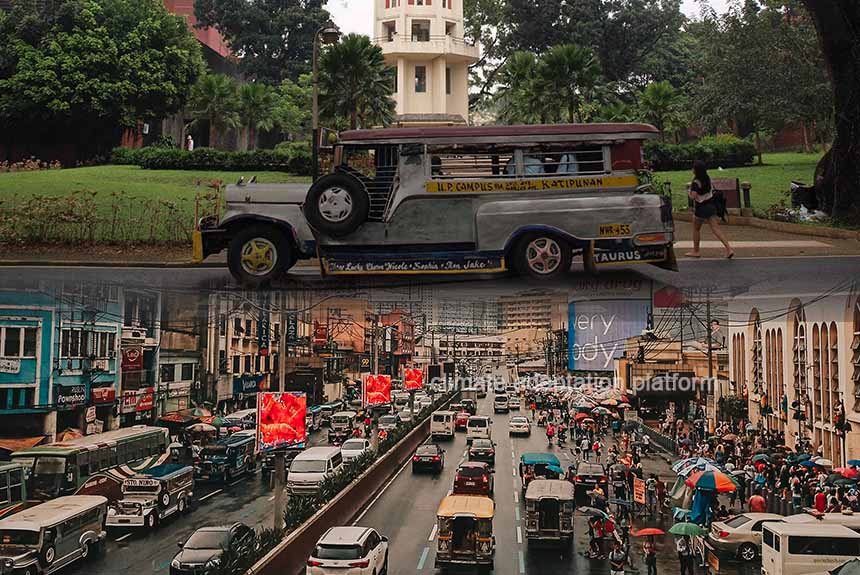The Philippine public utility jeepney (PUJ), or Jeepneys for short, is an iconic mode of transportation in the country. They are also the most popular and cheap mode of public transportation in the Philippines, known for their eye-catching decorations and crowded seating.
However, their popularity comes at a cost to the environment and the people’s health. These jeepneys are poorly and inadequately maintained to maintain the low fares and make them accessible to more people. As a result, they spew harmful pollutants, compromising the air quality in the urban areas in the Philippines.
A report from Clean Air Asia and Blacksmith Institute, diesel-powered, contribute 15% of the total particulate matter emissions in Metro Manila. Additionally, air pollution is considered a “silent killer”, and its damage to people’s health is estimated at USD 2.5 billion or about 1.55% of the Philippines’ gross domestic product (GDP) in 2009.
Phasing them out and replacing them with modern and cleaner public vehicles will reduce harmful air pollution emissions and improve passengers’ safety and comfort.
Philippines’s Jeepney Modernization Program
In a bid to phase out these old, smoke-belching traditional jeepneys, the government launched the Public Utility Vehicle Modernization Program in 2017, where they will be retired and replaced with vehicles meeting safety and environmental standards such as Euro 4 or higher emissions standards vehicles.
The program has attracted pushback from jeepney operators, citing the high cost of these modern and cleaner vehicles that varies between Php 1.5 million (US$26,600) to Php 2.8 million (US$49,700), which most of them say they could not afford and the resulting increase of jeepney fares could lead them to lose customer base as well.
The estimated cost of these modern jeepneys varies
Inquirer reports the Land Transportation Franchising and Regulatory Board (LTFRB) has approved the prototype of these modern jeepneys. They resemble the iconic look of the traditional jeepney but have added features like a higher ceiling that allows passengers to stand, handrails, built-in security cameras, and an environment-friendly Euro 5 engine that conforms with the safety and quality per the Philippine National Standards (PNS). LTFRB Chair Teofilo Guadiz also calls on local manufacturers to build these modern vehicles so imports will not be needed.
Towards the end of 2023, a local jeepney manufacturer presented its version of a fully electric jeepney, which they called “Francisco Jeepney”, naming it after their company, Francisco Motor Corporation (Cost of modernized, 2023). Its lower price at just below Php 1 million (US $ 17,700) for 1,000 units will make the jeepney more attractive to operators than the alternatives on the market.
Francisco, the owner, says they have lowered the cost of production firstly because it is made in the country, and there is no need to import these modern vehicles. They plan to make 25,000 units annually, and each vehicle can seat up to 22 people.
In January 2024, the car manufacturer announced its partnership with HDEX, a UK-based community-driven energy exchange, to spearhead hydrogen-powered jeepneys in the Philippines.
“We do not see hydrogen as an alternative fuel; rather, it is the fuel of the future,” Elmer Francisco, CEO of Francisco Motor Corporation, remarked.
The Philippines’ push to modernize its public vehicle fleet is a step in the right direction. Financial support to the jeepney operators will allow them to switch to cleaner vehicles and safeguard their livelihoods while providing Filipinos with a safe, reliable, convenient, and environmentally sustainable public transport solution.
Government support for local manufacturers that make these cleaner vehicle alternatives is crucial to ensure the program’s success. It will allow them to continue providing cost-effective and environmentally friendly vehicles while contributing to the local economy through the jobs and opportunities it creates domestically.
Producing these vehicles locally also means that the country does not need to import them, which can inflate costs and add to the carbon emissions.
Source:
Cartojano, A. (2023, March 9). Modernizing the Jeepney Fleet in the Philippines: Balancing Safety, Environmental, and Social Concerns. Retrieved from https://www.linkedin.com/pulse/modernizing-jeepney-fleet-philippines-balancing-safety-cartojano/
Lu, B. (2024, January 6). Navigating the landscape of jeepney modernization. Philippine News Agency. Retrieved from https://www.pna.gov.ph/opinion/pieces/813-navigating-the-landscape-of-jeepney-modernization
Cost of modernized, electric vehicles less than P1-M: Francisco Motors. (2023, December 1). ABS CBN. Retrieved from https://news.abs-cbn.com/video/news/12/01/23/cost-of-francisco-motors-electric-jeepneys-less-than-p1-m
eFrancisco Motor Corporation Wants To Develop Hydrogen-Powered Jeepneys. (2024, January 13). CarGuide. Retrieved from https://www.carguide.ph/2024/01/efrancisco-motor-corporation-wants-to.html
Bautista, J. (2023, March 7). Modern jeepney prototype gets approval of LTFRB. Inquirer.Net. Retrieved from https://newsinfo.inquirer.net/1739211/modern-jeepney-prototype-gets-approval-of-ltfrb
Black Smith Institute and Clean Air Asia. (2016). Alternative Technologies For the Philippine Utility Jeepneys: A Cost-Benefit Analysis. Clean Air Asia. Retrieved from https://cleanairasia.org/sites/default/files/2021-05/10.%20Alternative%20Technologies%20for%20the%20Philippines%20Utility%20Jeepney%20-%20A%20Cost-Benefit%20Study.pdf



Leave a Reply